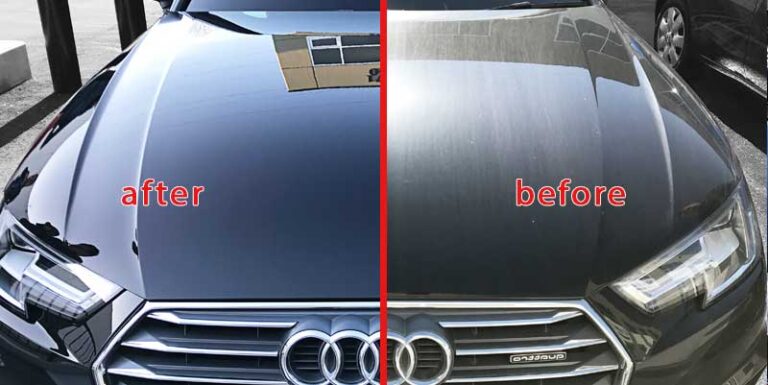How Ceramic Coating Philadelphia Guards Against UV Rays and Ecological Damages
How Ceramic Coating Philadelphia Guards Against UV Rays and Ecological Damages
Blog Article
Why Ceramic Covering Is the Ultimate Option for a Remarkable End Up
Ceramic finishing has actually emerged as a leading service for those seeking a remarkable surface for their lorries, many thanks to its remarkable durability and safety attributes. What factors really set ceramic finishing apart?
What Is Ceramic Finishing?

When applied appropriately, ceramic layer creates a hydrophobic surface that fends off water and dirt, making it easier to preserve and clean up. Unlike traditional waxes or sealants, which usually supply brief security, ceramic finishings can last for numerous years, depending on the item top quality and application method. The procedure of using ceramic covering needs precise preparation, consisting of extensive cleaning and often repaint adjustment, to ensure optimum bonding and efficiency.
Ceramic finishes are not limited to automotive surface areas; they can also be utilized on various materials, consisting of glass, steel, and plastics, supplying a flexible remedy for boosting defense. On the whole, ceramic coating represents a considerable development in surface defense technology, integrating both useful and aesthetic advantages for a vast array of applications.
Benefits of Ceramic Covering
While numerous surface area security choices exist, the benefits of ceramic finishing stick out as a result of its unique homes and resilient efficiency. Among the main benefits is its exceptional sturdiness. Ceramic Coating Philadelphia. Unlike standard wax or sealers that require constant reapplication, ceramic coatings provide a resistant layer that can last for numerous years, dramatically minimizing maintenance efforts
Another noteworthy advantage is improved security against environmental impurities. Ceramic coatings produce a hydrophobic surface area that wards off water, dirt, and different pollutants, making it simpler to clean. This function not only maintains the car's look however also decreases the risk of deterioration and oxidation, especially in harsh climate condition.
Additionally, ceramic finishings supply superior resistance to UV rays, stopping fading and destruction of paint over time. This UV security is critical for maintaining the visual worth of automobiles and surface areas revealed to guide sunlight.
Furthermore, the shiny surface attained with ceramic coating boosts the total aesthetic charm, providing surfaces a showroom-quality luster. In general, ceramic coatings stand for a substantial improvement in surface area security innovation, offering long-lasting advantages that cater to both practical and visual requirements.
Exactly How It Functions
Understanding the scientific research behind ceramic coatings reveals just how they offer such impressive protection and long life. At its core, a ceramic finish is a liquid polymer that chemically bonds with the vehicle's manufacturing facility paint.
The application procedure includes numerous actions, including surface prep work, which is crucial to achieving ideal attachment. As soon as applied, the coating goes through a healing process, throughout which it hardens and forms a semi-permanent bond with the paint surface. This bond is what distinguishes ceramic coatings from standard waxes and sealants, providing a longer-lasting protective obstacle that can endure for years.
Moreover, the density of the finishing can enhance its safety top qualities, ensuring that it can stand up to extreme problems. Eventually, the science of ceramic coatings combines innovative materials with ingenious application techniques to deliver an unmatched level of defense and aesthetic enhancement for cars.
Comparison With Standard Approaches
The benefits of ceramic finishes come to be particularly evident when compared to standard paint defense techniques such as waxes and directory sealants. While waxes use a temporary luster, usually lasting a few weeks to a couple of months, ceramic finishings give a long-lasting protective layer that can sustain for several years. This durability significantly minimizes the frequency of reapplication, making ceramic coatings an extra affordable service gradually.
Furthermore, traditional techniques commonly need extensive prep work and several applications to attain a satisfactory level of protection. On the other hand, ceramic coatings bond at a molecular level with the automobile's surface area, producing a durable guard versus environmental pollutants like UV rays, acid rainfall, and roadway salts. This bond boosts the car's resistance to scratches and swirl marks, which are common with typical waxes and sealers.
Furthermore, the hydrophobic homes of ceramic finishings push back water and dirt, resulting in less complicated cleansing and maintenance. On the other hand, wax and sealant-treated surfaces can bring in grime, demanding even more frequent washing - Ceramic Coating Philadelphia. Overall, ceramic coverings not just give exceptional protection yet likewise deliver a more enduring and visually enticing surface, establishing them as the recommended option for critical automobile proprietors
Application and Upkeep Tips

Making use of a foam applicator, apply the covering in small areas, following the supplier's guidelines regarding density and overlap. Allow enough curing time in between coats, dig this normally 24-hour, to make sure correct bonding. After application, it is critical to avoid exposure to water or rough elements for at the very least a week to enable the covering to fully heal.
In addition, using a ceramic maintenance spray can enhance the finish's hydrophobic properties and durability. Normal examinations for any kind of signs of wear will certainly help keep the finish's integrity and maintain that beautiful coating.
Conclusion
In verdict, ceramic finishing becomes a remarkable option for accomplishing a perfect automotive surface. Its exceptional toughness, safety qualities, and hydrophobic buildings dramatically improve the car's appearance while streamlining upkeep initiatives. By forming a durable bond with manufacturing facility paint, ceramic coating successfully guards against scrapes, UV rays, and environmental contaminants. With a lifespan expanding a number of years, this advanced service not only protects but also elevates the total aesthetic appeal of vehicles, making it an economical investment for cars and truck enthusiasts.

Report this page